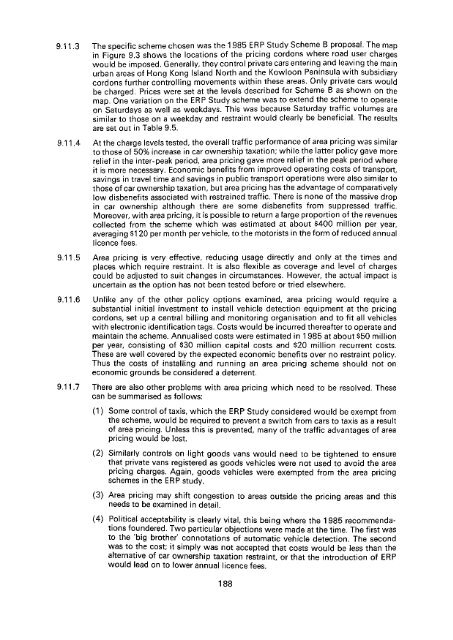Untitled - HKU Libraries - The University of Hong Kong
Untitled - HKU Libraries - The University of Hong Kong
Untitled - HKU Libraries - The University of Hong Kong
- No tags were found...
Create successful ePaper yourself
Turn your PDF publications into a flip-book with our unique Google optimized e-Paper software.
9.11.3 <strong>The</strong> specific scheme chosen was the 1 985 ERP Study Scheme B proposal. <strong>The</strong> mapin Figure 9.3 shows the locations <strong>of</strong> the pricing cordons where road user chargeswould be imposed. Generally, they control private cars entering and leaving the mainurban areas <strong>of</strong> <strong>Hong</strong> <strong>Kong</strong> island North and the Kowloon Peninsula with subsidiarycordons further controlling movements within these areas. Only private cars wouldbe charged. Prices were set at the levels described for Scheme B as shown on themap. One variation on the ERP Study scheme was to extend the scheme to operateon Saturdays as well as weekdays. This was because Saturday traffic volumes aresimilar to those on a weekday and restraint would clearly be beneficial. <strong>The</strong> resultsare set out in Table 9.5.9.11.4 At the charge levels tested, the overall traffic performance <strong>of</strong> area pricing was similarto those <strong>of</strong> 50% increase in car ownership taxation; while the latter policy gave morerelief in the inter-peak period, area pricing gave more relief in the peak period whereit is more necessary. Economic benefits from improved operating costs <strong>of</strong> transport,savings in travel time and savings in public transport operations were also similar tothose <strong>of</strong> car ownership taxation, but area pricing has the advantage <strong>of</strong> comparativelySow disbenefits associated with restrained traffic. <strong>The</strong>re is none <strong>of</strong> the massive dropin car ownership although there are some disbenefits from suppressed traffic.Moreover, with area pricing, it is possible to return a large proportion <strong>of</strong> the revenuescollected from the scheme which was estimated at about $400 million per year,averaging $120 per month per vehicle, to the motorists in the form <strong>of</strong> reduced annuallicence fees.9.11.5 Area pricing is very effective, reducing usage directly and only at the times andplaces which require restraint. It is also flexible as coverage and level <strong>of</strong> chargescould be adjusted to suit changes in circumstances. However, the actual impact isuncertain as the option has not been tested before or tried elsewhere.9.11.6 Unlike any <strong>of</strong> the other policy options examined, area pricing would require asubstantial initial investment to install vehicle detection equipment at the pricingcordons, set up a central billing and monitoring organisation and to fit all vehicleswith electronic identification tags. Costs would be incurred thereafter to operate andmaintain the scheme. Annuaiised costs were estimated in 1 985 at about $50 millionper year, consisting <strong>of</strong> $30 million capital costs and $20 million recurrent costs.<strong>The</strong>se are well covered by the expected economic benefits over no restraint policy,Thus the costs <strong>of</strong> installing and running an area pricing scheme should not oneconomic grounds be considered a deterrent.9.11.7 <strong>The</strong>re are also other problems with area pricing which need to be resolved. <strong>The</strong>secan be summarised as follows:(1) Some control <strong>of</strong> taxis, which the ERP Study considered would be exempt fromthe scheme, would be required to prevent a switch from cars to taxis as a result<strong>of</strong> area pricing. Unless this is prevented, many <strong>of</strong> the traffic advantages <strong>of</strong> areapricing would be lost.(2) Similarly controls on light goods vans would need to be tightened to ensurethat private vans registered as goods vehicles were-not used to avoid the areapricing charges. Again, goods vehicles were exempted from the area pricingschemes in the ERP study.(3)' Area pricing may shift congestion to areas outside the pricing areas and thisneeds to be examined in detail.(4) Political acceptability is clearly vital, this being where the 1985 recommendationsfoundered. Two particular objections were made at the time. <strong>The</strong> first wasto the 'big brother' connotations <strong>of</strong> automatic vehicle detection. <strong>The</strong> secondwas to the cost; it simply was not accepted that costs would be less than thealternative <strong>of</strong> car ownership taxation restraint or that the introduction <strong>of</strong> ERPwould lead on to lower annual licence fees.188
















